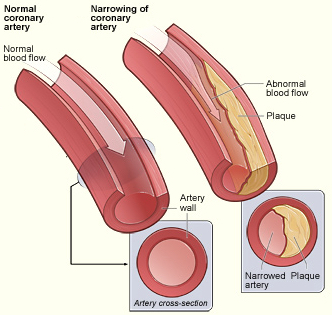Clearing out the clutter: ‘senolytic’ drugs improve vascular health in mice
February 11, 2016

(Left) Normal coronary artery with normal blood flow. Right: a coronary artery narrowed by plaque, limiting the flow of oxygen-rich blood through the artery. (credit: NIH)
Mayo Clinic researchers have demonstrated the first study in which repeated treatments to remove senescent cells (cells that stop dividing due to age or stress) in mice improve age-related vascular conditions — and may possibly reduce cardiovascular disease and death.
The researchers intermittently gave the mice a cocktail of two senolytic drugs (ones that selectively induce cell death): dasatinib (a cancer drug, trade name Sprycel) and quercetin*. The drugs cleared (killed off) senescent cells in naturally aged and atherosclerotic mice. The treatment did not reduce the size of plaques in mice with high cholesterol, but did reduce calcification of existing plaques on the interior of vessel walls.**
The findings appear online (open access) in Aging Cell.
“Our finding that senolytic drugs can reduce cardiovascular calcification is very exciting, since blood vessels with calcified plaques are notoriously difficult to reduce in size, and patients with heart-valve calcification currently do not have any treatment options other than surgery,” says Jordan Miller, Ph.D., Mayo cardiovascular surgery researcher and senior author of the paper.
“While more research is needed, our findings are encouraging that one day removal of senescent cells in humans may be used as a complementary therapy along with traditional management of risk factors to reduce surgery, disability, or death resulting from cardiovascular disease.”
The coauthors include two researchers from Newcastle University. The research was supported by the National Institutes of Health, Mayo Clinic Center for Regenerative Medicine, and the Connor Group and Noaber Foundation. Drs. Kirkland, Tchkonia, Zhu, Pirtskhalava, and Ms. Palmer have a financial interest related to the research.
* Quercetin is found in many fruits, vegetables, leaves and grains. It can be used as an ingredient in supplements, beverages, or foods. — Wikipedia
** Prior studies at Mayo showed chronic removal of the cells from genetically-altered mice can alter or delay many of these conditions, and short-term treatment with drugs that remove senescent cells can improve the function of the endothelial cells that line the blood vessels. This study, however, looked at the structural and functional impacts of cell clearance using a unique combination of drugs on blood vessels over time. Mice were 24 months old when the drugs were administered orally over a three-month period following those initial two years. A separate set of mice with high cholesterol was allowed to develop atherosclerotic plaques for 4 months and were then treated with the drug cocktail for two months. — Mayo Clinic
Abstract of Chronic senolytic treatment alleviates established vasomotor dysfunction in aged or atherosclerotic mice
Rationale: While reports suggest a single dose of senolytics may improve vasomotor function, the structural and functional impact of long-term senolytic treatment is unknown.
Objective: To determine whether long-term senolytic treatment improves vasomotor function, vascular stiffness, and intimal plaque size and composition in aged or hypercholesterolemic mice with established disease.
Methods and Results: Senolytic treatment (intermittent treatment with Dasatinib + Quercetin via oral gavage) resulted in significant reductions in senescent cell markers (TAF+ cells) in the medial layer of aorta from aged and hypercholesterolemic mice, but not in intimal atherosclerotic plaques. While senolytic treatment significantly improved vasomotor function (isolated organ chamber baths) in both groups of mice, this was due to increases in nitric oxide bioavailability in aged mice and increases in sensitivity to NO donors in hypercholesterolemic mice. Genetic clearance of senescent cells in aged normocholesterolemic INK-ATTAC mice phenocopied changes elicited by D+Q. Senolytics tended to reduce aortic calcification (alizarin red) and osteogenic signaling (qRT-PCR, immunohistochemistry) in aged mice, but both were significantly reduced by senolytic treatment in hypercholesterolemic mice. Intimal plaque fibrosis (picrosirius red) was not changed appreciably by chronic senolytic treatment.
Conclusions: This is the first study to demonstrate that chronic clearance of senescent cells improves established vascular phenotypes associated with aging and chronic hypercholesterolemia, and may be a viable therapeutic intervention to reduce morbidity and mortality from cardiovascular diseases.